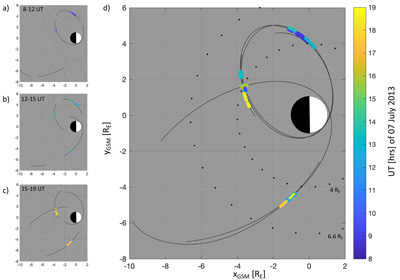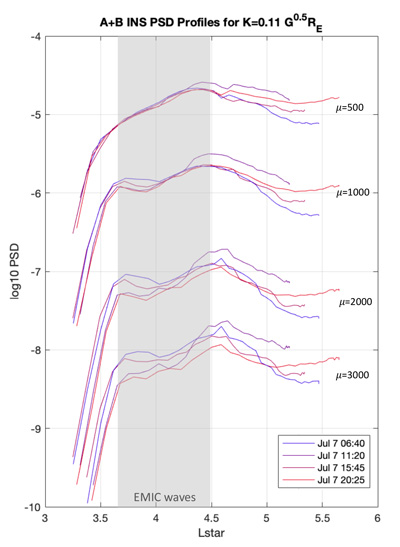
2020 THEMIS SCIENCE NUGGETS
Multipoint measurements to understand the structure, generation, and impact of EMIC wave activity in the inner magnetosphere
by Lauren Blum
University of Colorado Boulder – Astrophysics and Planetary Science (APS) Department, Laboratory for Atmospheric and Space Physics (LASP)
Introduction
Electromagnetic ion cyclotron (EMIC) waves, electromagnetic emissions below and approaching ion cyclotron frequencies, have long been studied and observed in Earth’s magnetosphere. These waves have been shown to resonantly interact with multiple particle populations in the inner magnetosphere and are an important loss process for both ring current ions and radiation belt electrons. Key variables for quantifying the effects of these waves on energetic particle populations are the spatial and temporal distributions of wave activity. While wave durations, as measured in situ, are often quite short, lasting on average ~20 minutes and occurrence rates typically a few to 10%, ground observations have shown EMIC wave activity extending multiple hours. However, due to propagation and ducting effects, EMIC waves are not always observed on the ground when and where they occur in space; thus in situ observations are needed for estimating spatial and temporal scales of EMIC wave source regions to determine the net impact of these waves on ion and electron dynamics in the magnetosphere.
Results
Here we utilize multiple spacecraft to estimate the radial and azimuthal (or angular width around the Earth, in local time) extents as well as duration of an EMIC wave event occurring on the nightside of the inner magnetosphere on 07 July 2013. Combined observations from THEMIS, Van Allen Probes, and GOES indicate that although the waves were constrained to a narrow radial extent during this period, they persisted for ~10+ hours universal time (UT) and spanned nearly 12 hours in magnetic local time (MLT). The solar wind conditions, geomagnetic activity, and plasma environment are also examined, to better understand the driving conditions for such persistent, azimuthally extended night-side EMIC waves. Finally, the evolution of the outer radiation belt during this period is presented, to explore the effect of the extended EMIC wave activity on trapped energetic electrons in Earth’s outer radiation belt.
Magnetic field observations from multiple spacecraft are combined to examine the EMIC wave event on 07 July 2013. Figure 1 shows the solar wind and geomagnetic conditions during the period of interest (left panels), as well as magnetic field observations of EMIC wave activity from the Van Allen Probes (RBSP) and THEMIS spacecraft (right panels). While these wave observations appear short-lived, the waves are observed on consecutive orbits and by multiple spacecraft throughout the 10 hr period on 07 July (shaded in grey in Fig 1 left panels).
| Figure 1. (a) Solar wind Bz, (b), flow speed, (c) proton density, (d) flow pressure, (e) AE, (f) Sym-H, and (g) Kp from 05 July through 08 July 2013. Van Allen Probe (h and i) and THEMIS (j, k, and l) magnetic field spectrograms from one day of this extended period, marked by the pink box, are shown in the right hand panels. Light grey lines overplotted on these panels show the local H+, He+, and O+ cyclotron frequencies as measured by the spacecraft. EMIC waves are observed by (h) RBSP A around 8 UT and 13 UT, (i) RBSP B around 9 UT, 13 UT and 18 UT, THEMIS E around 12 UT and 16 UT, and THEMIS A around 15-18 UT. This extended period of wave activity is highlighted on the left hand panels by the grey shaded region. |
To get a better sense of where and when the patches of wave activity were observed by each spacecraft, Figure 2 presents the orbits of RBSP A and B as well as THEMIS E and A. Panels (a), (b), and (c) show 3-4 hour periods throughout 07 July 2013, with spacecraft trajectories marked by the black lines and intervals of wave activity indicated by the colored markers. The color corresponds to the time (UT) of the wave observations (see color bar). Figure 4(d) is a compilation of panels (a-c), and shows the complete orbits and locations of wave activity from 08-19UT on this day. These combined observations indicate that waves were observed near-simultaneously by multiple spacecraft spanning the nightside, around 8-9 UT (dark blue, e.g. panel a), 13-14 (light blue/teal, panel b), 16 (green), and 18-19 (yellow, panel c) at a range of local times including dusk, pre-midnight, and dawn. Waves were also observed in these given locations on multiple consecutive orbits, hours apart. For example, in the pre-midnight sector, waves are first observed by RBSP B at 9 UT, then RBSP A at 13-14 UT, THEMIS E at 16 UT, and again RBSP B at 18-19 UT.
| Figure 2. The locations of RBSP A and B and THEMIS A and E in GSM coordinates. Black lines show the spacecraft trajectories and colored markers the time periods when EMIC wave activity was observed, with color indicating the UT of the wave measurement on 07 July 2013. (a) Spacecraft trajectories from 08-12 UT, (b) 12-15 UT, (c) 15-19 UT, and (d) the full spacecraft and wave locations from 08-19 UT, during the period of extended wave activity. |
The observations presented in Section 2 and Figures 1-3 reveal persistent EMIC waves occurring in a narrow L shell but extended across a broad range of MLTs on the nightside of the inner magnetosphere on 7 July 2013. To better understand the cause of these waves and their spatial and temporal structure, we return to the solar wind and geomagnetic conditions presented in Figure 1. While most large-scale dayside EMIC waves are driven by sudden enhancements in the solar wind dynamic pressure, the waves on 07 July are not associated with any obvious pressure changes or magnetopause compressions. They are also not associated with enhanced Kp/AE activity or localized ion injections, as many duskside EMIC wave events are. Instead, in this event, it is just after these dynamics during a calmer period of magnetospheric relaxation that the waves turn on and persist for 10+ hours. The wave structure appears to follow the inner edge of the plasmasheet where it encounters the outer edge of an expanding plasmasphere, in a radially narrow but azimuthally extended region of these overlapping plasma populations spanning the nightside inner magnetosphere. The more slowly varying storm recovery phase may allow the waves to persist in their given location for this extended period, compared to more dynamic storm and substorm periods during which magnetospheric reconfiguration and plasma dynamics change more rapidly.
Finally, we examine the response of the outer radiation belt during this event to look for evidence of scattering and loss. As the EMIC waves on 07 July 2013 span nearly half the drift orbit of a relativistic electron in the heart of the outer radiation belt and persist many hours, they have the potential to produce significantly larger effects than statistical EMIC wave occurrence rates would suggest. Figure 5 shows radial profiles of phase space density (PSD) as measured by RBSP A and B on 06-07 July for multiple adiabatic first invariant μ values. The rough location in L* of the EMIC wave activity as measured by the Van Allen Probes is marked in grey. A local minimum in PSD is observed to develop around this location throughout the course of the EMIC wave period, more prevalent at higher µ values (≥1000 MeV/G). These patterns are similar to those observed previously and suggested to be indicators of local scattering and loss driven by EMIC wave activity.
| Figure 3. Phase space density profiles measured during inbound passes by RBSP A and B on 07 July 2013. The approximate location in L* of the EMIC wave activity is marked in grey. |
Conclusion
The wave observations on 07 July 2013 provide a striking example of a persistent EMIC wave active region spanning the nightside inner magnetosphere during the recovery phase of a moderate geomagnetic storm. A summary of the findings during this event are outlined below:
- The EMIC wave activity on 07 July is localized in L shell but spans 10+ hrs in UT and nearly 12 hrs in MLT. Multipoint in situ measurements support previous ground and in situ observations that EMIC waves are often radially narrow but extended in UT, confirming that single spacecraft measurements (particularly from highly elliptical orbits) can significantly underestimate EMIC wave durations.
- Wave activity occurs across the nightside of the inner magnetosphere during the recovery phase of a storm, where hot ions overlap an outwardly expanding plasmasphere over an extended range of local times. The more slowly varying storm recovery phase may allow the waves to persist in their given location for this extended period, compared to more dynamic storm and substorm periods.
- Signatures in the trapped outer radiation belt electrons observed during this event are consistent with EMIC-driven scattering and loss of MeV electrons from the outer radiation belt. Such persistent, extended EMIC waves have the potential to produce significant effects on energetic particle dynamics and loss in the inner magnetosphere.
Reference
Blum, L. W., R. Bhanu, M. Denton, Q. Schiller (2020), Persistent EMIC wave activity across the nightside inner magnetosphere, Geophys. Res. Lett 47 (6), e2020GL087009.Biographical Note
Lauren is an assistant professor at University of Colorado Boulder. She received a Bachelor's in Physics from Dartmouth College and a PhD from the University of Colorado in Aerospace Engineering Science. Her current research focuses on understanding the energetic particle environment in near-Earth space, through analysis of spacecraft measurements as well as instrument and small satellite development.
 Please send comments/suggestions to
Emmanuel Masongsong / emasongsong @ igpp.ucla.edu
Please send comments/suggestions to
Emmanuel Masongsong / emasongsong @ igpp.ucla.edu



